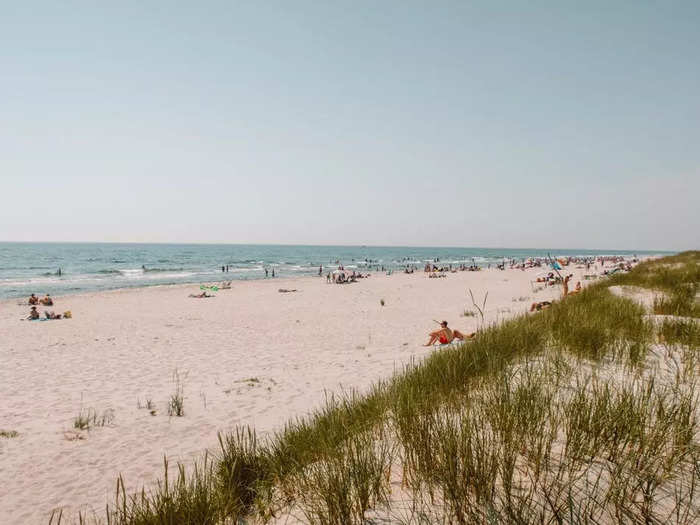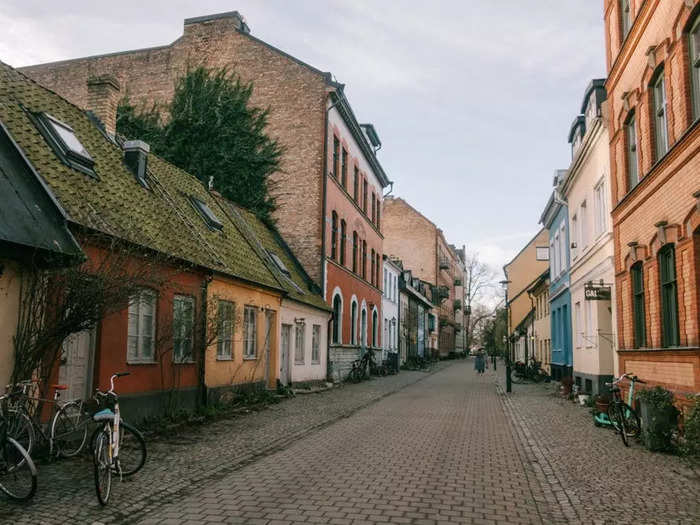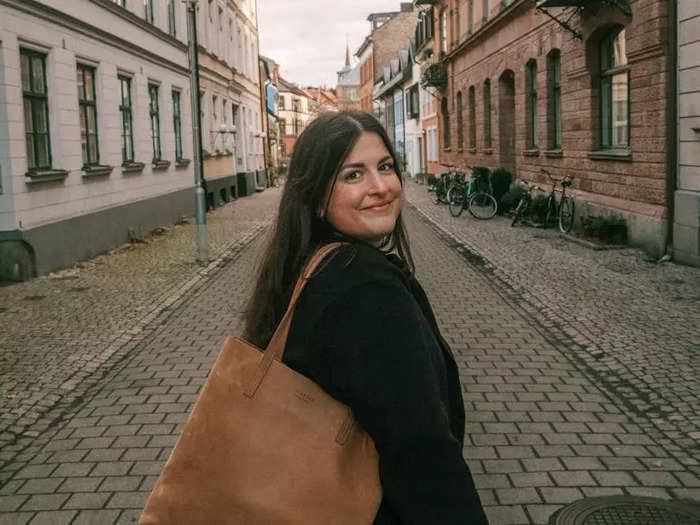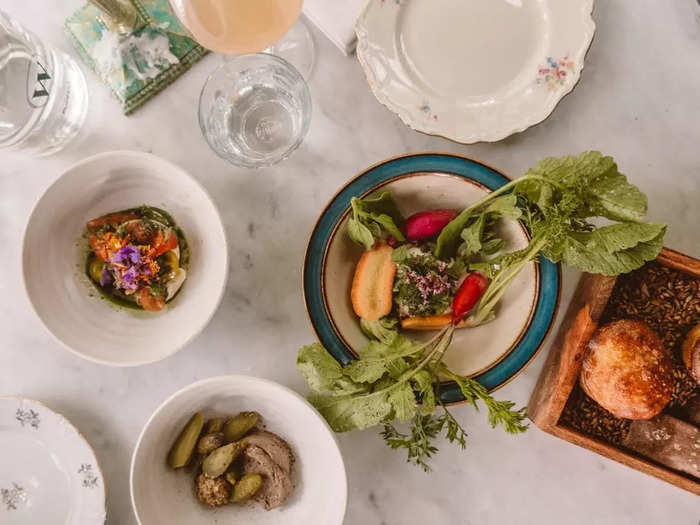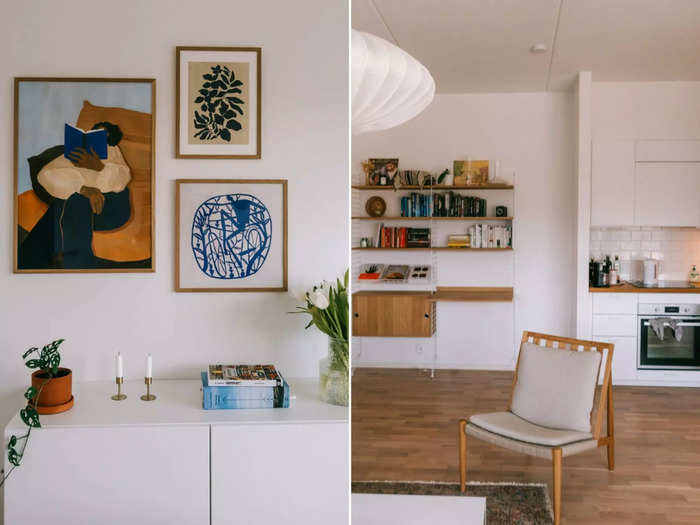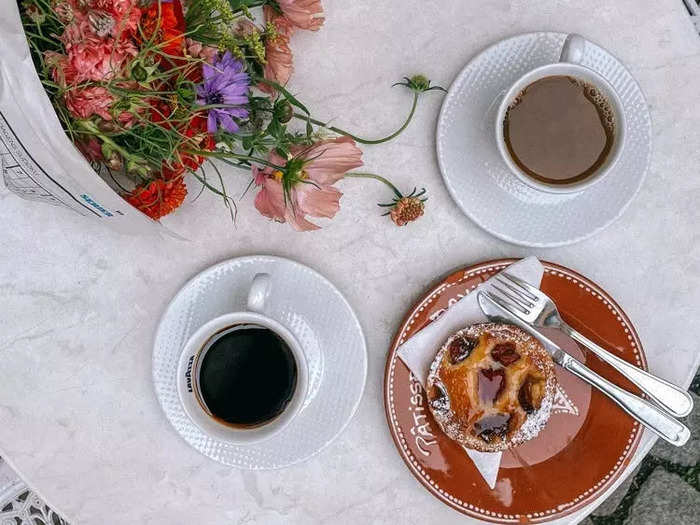The author moved to Sweden from Ontario, Canada, four years ago and has no plans to leave.Madeline Robson
- After meeting my Swedish partner, I moved from Canada to Sweden in 2019.
- At first I planned to stay temporarily — now more than four years later, I have no plans to leave.
In 2017, I traveled from my hometown of Windsor in Ontario, Canada, to New Orleans, Louisiana, to celebrate a friend's bachelorette party. On the last night of the trip, I met a Swede named Sebastian who was solo traveling in the US. We clicked immediately, and although I left New Orleans the next day, we kept in touch.
A few weeks later, he visited me in Canada for two weeks. We spent the next year and a half dating long-distance, flying back and forth, and knew that one of us would eventually have to move.
I'd always wanted to spend time living abroad, so I happily volunteered. I obtained a temporary work visa in Sweden with the intention of only staying for a few years. And in February 2019, I bought myself and my cat a one-way ticket to Copenhagen, Denmark, which is about a 40-minute drive across the Øresund strait from the city of Malmö, Sweden.
My partner Sebastian is from the Malmö area, so it was a natural choice to base ourselves in the city. But I quickly fell in love with the culture, way of life, and openness of the people in Malmö — so much so that I bought an apartment and now more than four years later, I have no plans to leave. I can't picture myself living anywhere else in Sweden.
Over the years, I have gained such an appreciation for everyday life here. Here are a few specific things that surprised me about the Swedish culture and lifestyle, and why I love living here.
Swedes have mastered work-life balance.
Southern Sweden is filled with white sand beaches where Swedes spend their long summer holidays. Madeline Robson
One of my biggest culture shocks when I started working in Sweden was finding out that by law, I was entitled to a minimum of 25 paid vacation days, or five weeks, per year. And that in many cases, some employers will offer their employees even more.
Adding to that, workers in Sweden are entitled by law to take four of the five weeks as continuous vacation during the summer period, and many employees also receive extra pay on vacation days to incentivize them to take the time off.
At first, I wondered how it would be possible to take that much time off, and spent my entire first year feeling guilty about taking vacation. Then once summer rolled around, my employer said that we had to take at least three weeks off to recharge. I quickly learned that during the summer, it is typical for most people to take four or five weeks of consecutive vacation.
It took some adjusting, but four years later, I have finally let go and learned to embrace my summer break like I did when I was a kid.
I learned that Sweden is one of the best places in the world to be a parent.
A quiet street in Malmö, Sweden. Madeline Robson
Swedish parents are entitled to 480 days of paid parental leave per child, which can be split between the parents. Moving here from Canada, where I would have been entitled to up to 18 months of partially paid parental leave, many could argue that this shouldn't really be a culture shock. However, the way Swedish parental leave works in practice was really surprising to me.
I was most surprised to learn that a certain proportion of the leave is required to be taken by the father or non-birthing parent. And it isn't uncommon for the leave to be split 50/50.
I also learned that parents can take temporary parental leave of up to 120 days per year to care for a sick child, up until the child is 12 years old. This means that parents of young children can often use a combination of parental leave and vacation days in the summertime to take up to seven or eight weeks off to spend quality time with their kids.
And the perks don't stop there. Students get free lunches at school every day, and parents of young children receive a monthly allowance to help cover the costs of preschool. And with free university, saving for education isn't as much of a stress for Swedish parents.
I am convinced that there are very few, if any, better places to be a parent.
Kids often come first, and then you might get married later.
The author learned that choosing to have kids before marriage can be common in Sweden. Madeline Robson
When I lived in Canada, I felt a lot of pressure to hit various life milestones in a certain order, and by a certain age. When I moved to Sweden, I was surprised to learn that I could throw many of those rules out the window.
I noticed in many cases that Swedes have kids before they are married. And it is quite common to choose to never marry at all.
If a couple does decide to get married, weddings are also much smaller than what I was used to in Canada. I was shocked the first time someone told me that they were having a big wedding, and proceeded to say that they would be inviting 70 guests. I had never been to a wedding with less than 100 people before.
But my favorite thing about Swedish weddings is that their traditions are gender equal. Both partners wear engagement rings, and the couple often walks down the aisle together. And when I tell people that my partner and I are planning to get married, they ask us whose last name we'll take, mine or his.
There are also cases where couples decide to choose their own unique last name so that it's fair and special for just the two of them. Selecting a new last name is now something my partner and I are considering doing ourselves.
Many Swedes can be reserved, until you get to know them.
The author has found Swedes to be more reserved when first meeting, but big fans of giving hugs. Madeline Robson
Prior to moving here, I heard a lot about how Swedish people have a reputation for being reserved. As a friendly Canadian, knowing this made me nervous about connecting with locals and making friends.
After moving to Malmö, I quickly learned that Swedish people are not likely to engage in small talk, and in a situation where they don't know what to say, they will probably default to discussing the weather. And if you ask them casually how they are doing, they will answer that question very literally.
But one of my favorite things about Swedes that I learned over time, is that while they may not be so keen to engage with strangers, they are incredibly loyal, kind friends once you get to know them. They just choose to spend their time a bit more intentionally and keep their circles small.
There's one habit I picked up on that is not so reserved — Swedes are big fans of giving hugs. If you've met someone only once before, you can now assume that you are on a hugging basis and they are guaranteed to greet you with a hug the next time they see you.
Sustainable and seasonal eating is valued — but don't ask a Swede about their secret mushroom spot.
The author says many restaurant menus rotate weekly or monthly to prioritize freshly sourced products. Madeline Robson
New Nordic cuisine isn't just a trendy dining experience; in many ways, it's inspired by how Swedes eat sustainably every day. When I first moved here, I noticed how my Swedish friends talked about wild garlic, asparagus, or strawberry season with the same enthusiasm that Canadians talk about hockey playoffs.
And then there's the foraging culture. If you hear a Swede talk about their secret mushroom foraging spot, you might think they are kidding. But most people will not even share this information with their family members. If you want to make a Swede feel uncomfortable, just ask them where they found their chanterelles.
I have found that people here are generally very sustainability-minded in many ways, including what they eat. Through this, I have a newfound appreciation for simplifying the way I eat by choosing seasonal products, buying locally, and preparing food with natural ingredients.
Swedes live for summer, and Swedish Midsummer is the best day of the year.
On the longest day of the year, people in Sweden wear flowers in their hair and sing songs around the Midsummer pole. Madeline Robson
In the Nordics, the winters are dark. I live in the southernmost part of Sweden and during the darkest days of the year, we only get about six hours of light. And as you head north, it's significantly less. In my experience, it's hard to truly understand what this limited sunshine feels like unless you've lived through an entire winter in Sweden.
While the winter darkness is difficult, I think the summer more than makes up for it with long days and weeks-long summer holidays. I've always loved summertime, although it lost a bit of its novelty once I grew up and started working. But since moving here to Sweden, it feels magical again. The late-night sunshine and the fact that many people are on vacation at the same time makes it feel special.
And then there is the highlight of the season: Swedish Midsummer.
In the summer months, the sunlight shines late into the night, and on the longest day of the year, Swedes celebrate the summer solstice. It's a day where they retreat out of the city to cottages in the countryside, pick wildflowers to make flower crowns, eat traditional seasonal foods like herring, potatoes, and strawberries, and dance around a Midsummer pole singing folk songs.
It may sound a bit strange but I promise, it's incredibly idyllic and nothing like the horror movie.
Swedes are very proud of their homes and love to give house tours to new guests.
Inside the author's Malmö home, with decor inspired by Scandinavian interior design. Madeline Robson
Scandinavia is the land of interior design, and Sweden is the home of IKEA, so it may not be a surprise that many Swedes are very proud of their homes. In line with the sustainable mindset, I have found that many Swedes choose their furniture intentionally. I have also heard many Swedes say that they are saving up to buy classic, timeless furniture that they can keep for decades and hand down to their children, instead of repurchasing new trendy pieces every few years.
Eating out or grabbing drinks in Sweden is expensive, so I've also noticed that Swedes enjoy hosting loved ones in their homes. But if you get invited to a Swedish home for the first time, you should be prepared for the Swedish house tour or husesyn. When I moved here and was first visiting the homes of Swedish friends, I began to notice this pattern.
When you arrive at a Swede's home as a first-time guest, it is common that they will offer to take you on a house tour before you sit down. And this isn't just a quick tour of the common living spaces. In fact, no details are spared. I've been shown closet space, kitchen storage, kids' bedrooms, and even parking spaces.
Swedes take their coffee breaks very seriously, both at work and on the weekends.
Swedes enjoy fika, or coffee breaks, outdoors during all seasons. Madeline Robson
Swedes take coffee breaks so seriously that they have their own untranslatable word to describe taking a coffee break. Fika can be loosely described as taking a break with friends or loved ones to enjoy a coffee, sometimes paired with a sweet treat or snack.
Before moving to Sweden I thought it sounded like a novelty. But I quickly realized that Swedes drink a lot of coffee, and that fika is a word I would be hearing every single day.
When I started working in Sweden, I began to notice how seriously Swedish employees take their fika breaks. We would start the day at work with a breakfast fika, and occasionally take a mid-morning fika. And then my Swedish colleagues would suggest another fika after lunch. Before I knew it, I was ditching my to-go iced lattes in favor of dark roast drip coffee with a splash of oat milk, which just so happens to have been invented locally by Oatly in the 1990s.
Coffee is also a big part of social life in Sweden. On weekends, it is common to have a friend ask to meet you for a fika to catch up, or they might choose to host a Sunday fika at home. Let's just say my coffee consumption has drastically increased since moving to Sweden, despite the fact that I no longer take my coffee to go.
Although I miss some aspects of my life in Canada, after four years in Sweden, I find myself happier and more appreciative of the little things in life.
The author says living in Sweden has helped her slow down and enjoy life more. Madeline Robson
To many, life in Scandinavia can seem utopian, but it isn't perfect and there are also many things that I miss about living in Canada. Missing out on the little moments with family and friends is easily the hardest part of living so far away. But I also really miss the natural friendliness and kindness of Canadians, and the bright snowy winters, especially compared to the dark rainy winters that we have in Malmö.
But despite what I miss about my home country, the perks of living in Sweden are a big part of why I've decided to stay in the Nordics. Coming from a busy, on-the-go routine in Canada, I was quickly forced to slow down when I moved overseas. My life moves a bit slower here in Sweden, but has still been full of exciting new adventures and opportunities.
And while I will never be able to fully let go of some of the deeply-ingrained habits that I learned over almost three decades living in Canada, four years later I find myself happier, more comfortable in my own skin, and more appreciative of the little things in life. And I'm looking forward to seeing where this journey takes me.

